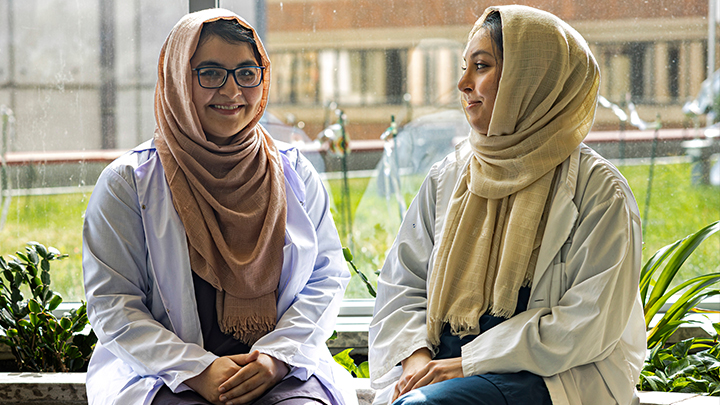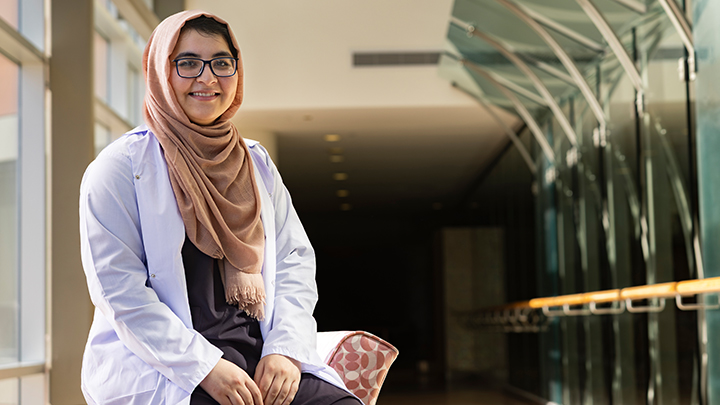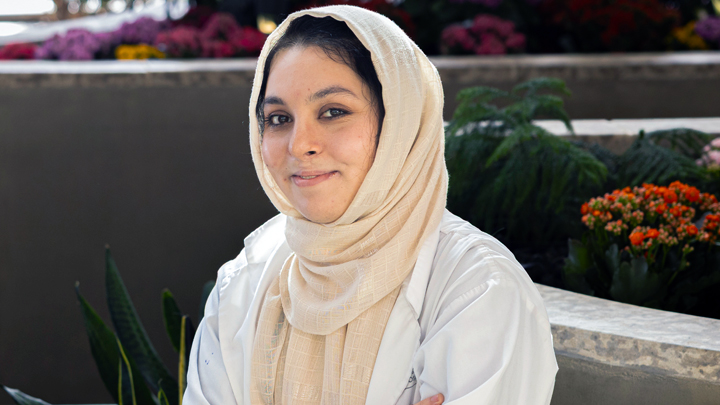
April 28, 2025

Edmonton-raised sisters Nabeela Khan, left, and Laila Naheed received their medical degree from Pakistan in 2021 and now work as associate physicians at the University of Alberta Hospital. Photo by Evan Isbister.

Nabeela Khan is currently preparing to begin her three-year residency at the University of Calgary in July. Photo by Evan Isbister.

Laila Naheed will complete her associate physician training by the end of July and plans to build a career in internal medicine. Photo by Evan Isbister.
Story by Katie McLaughlin | Photos by Evan Isbister
EDMONTON — Sisters Nabeela Khan and Laila Naheed always knew they wanted to be doctors.
Born in Pakistan and raised in Edmonton, both women started their medical journey in 2015 by going back to their birth country to attend the Khyber Girls Medical College in the city of Peshawar. This was a once-in-a-lifetime adventure that would not only lead to a medical degree, but allow them to connect with their culture, visit family and learn their native language of Pashto—together.
After graduating from medical school in 2021 and then completing the mandatory one-year clinical training in Pakistan—known as a “house job”—Khan and Naheed returned to Edmonton as International Medical Graduates (IMGs).
That’s when their journey towards practising medicine in Alberta began. “I knew it was going to be a challenge when I returned to Alberta, because it’s a long process for IMGs to be able to start practising medicine,” says Khan. “The sooner you start the assessment process after your training, the better.”
That’s exactly what they did. Khan and Naheed began taking some of the exams that are required to be able to practise in Alberta, and Khan began working in health research. That’s when she learned about the associate physician role at Alberta Health Services (AHS)—a role that sees IMGs delivering acute care coverage in various medical departments, under the supervision of a physician.
“Associate physicians play an invaluable role in our acute care settings,” says Dr. Saifal Anwar, a general internal medicine physician and associate clinical professor at the University of Alberta Hospital. “They bring a high level of clinical skill, often grounded in diverse international experience, and contribute meaningfully to patient care.”
Khan submitted her application and in September 2024 she started in general internal medicine at the University of Alberta Hospital. Five months later, Naheed began in the same role, at the same hospital and in the same clinical area.
“This role is a great opportunity for IMGs who want to do hands-on patient care,” Khan says. “Our goal is to practise medicine, and this allows us to do that. It’s a great long-term career option for some IMGs, and a great pathway for those who eventually want to pursue residency so they can practice independently.”
Associate physicians are assigned patients from the units they’re supporting. They speak with patients and families, take medical histories and vitals, review lab and diagnostic results, develop and modify care plans and ensure the plans are implemented. They do this with the support and guidance of their supervising physician, as well as other team members such as residents, medical students and pharmacists.
“You learn a lot when you’re actually seeing and assessing a patient yourself, rather than observing,” says Naheed. “Even though I have a medical degree, I need to learn the Canadian healthcare system and the typical patient population and prevalent diseases we see here. It’s very different from Pakistan. This role is a great way to do that.”
Naheed says that the team-based model they work in also gives her an opportunity to stay updated on clinical knowledge as they discuss patients and treatments. Khan adds: “By working together and supporting each other, we can provide more comprehensive care to our patients while also helping to reduce team burnout.”
Dr. Anwar says: “The presence of associate physicians improves continuity, enhances team-based care, eases the workload for attending physicians and ultimately benefits both patients and the healthcare system.”
As IMGs, Khan and Naheed offer some advice to others who want to practise medicine in Canada.
“Don’t give up,” says Khan. “Keep your options open and consider roles that give you direct experience in patient care, like an associate physician. You’ll eventually find a place for yourself in the healthcare system, and hopefully, it’s where you want to be.”
Naheed adds: “Nothing in life is easy; you need to work hard for what you want. The process for IMGs to practise in Canada can be long and hard, and there’s a lot to learn. You need to persevere and trust that you can do it.”
So, what’s next for these sisters?
Khan has been matched to a residency program at the University of Calgary and plans to begin her three-year residency in July. She hopes to one day return to Edmonton to practise in endocrinology.
Naheed will complete her associate physician training by the end of July. She’s passionate about internal medicine, specifically on diagnosing and treating a wide range of adult health issues, and is dedicated to building a career in this field.
“My goal at the end of the day is to serve people in whatever way possible,” she says.